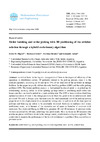Identificador persistente para citar o vincular este elemento:
https://accedacris.ulpgc.es/jspui/handle/10553/114420
| Título: | Order batching and order picking with 3D positioning of the articles: solution through a hybrid evolutionary algorithm | Autores/as: | Miguel, Fabio M. Frutos, Mariano Méndez, Máximo Tohmé, Fernando |
Clasificación UNESCO: | 120302 Lenguajes algorítmicos | Palabras clave: | Evolutionary algorithm Local Search Optimization Order batching Order picking |
Fecha de publicación: | 2022 | Publicación seriada: | Mathematical Biosciences and Engineering | Resumen: | A critical factor in the logistic management of firms is the degree of efficiency of the operations in distribution centers. Of particular interest is the pick-up process, since it is the costliest operation, amounting to 50 and up to 75% of the total cost of the activities in storage facilities. In this paper we jointly address the order batching problem (OBP) and the order picking problem (OPP). The former problem amounts to find optimal batches of goods to be picked up, by restructuring incoming orders by either splitting up large orders or combining small orders into larger ones that can then be picked in a single picking tour. The OPP, in turn, involves identifying optimal sequences of visits to the storage positions in which the goods to be included in each batch are stored. We seek to design a plan that minimizes the total operational cost of the pick-up process, proportional to the displacement times around the storage area as well as to all the time spent in pick-ups and finishing up orders to be punctually delivered. Earliness or tardiness will induce inefficiency costs, be it because of the excessive use of space or breaches of contracts with customers. Tsai, Liou and Huang in 2008 have generated 2D and 3D instances. In previous works we have addressed the 2D ones, achieving very good results. Here we focus on 3D instances (the articles are placed at different levels in the storage center), which involve a higher complexity. This contributes to improve the performance of the hybrid evolutionary algorithm (HEA) applied in our previous works. | URI: | https://accedacris.ulpgc.es/handle/10553/114420 | ISSN: | 1547-1063 | DOI: | 10.3934/mbe.2022259 | Fuente: | Mathematical Biosciences and Engineering [ISSN 1547-1063], v. 19 (6), p. 5546-5563, (Marzo 2022) |
| Colección: | Artículos |
Citas SCOPUSTM
5
actualizado el 08-jun-2025
Citas de WEB OF SCIENCETM
Citations
4
actualizado el 08-jun-2025
Visitas
63
actualizado el 18-feb-2024
Descargas
43
actualizado el 18-feb-2024
Google ScholarTM
Verifica
Altmetric
Comparte
Exporta metadatos
Los elementos en ULPGC accedaCRIS están protegidos por derechos de autor con todos los derechos reservados, a menos que se indique lo contrario.
